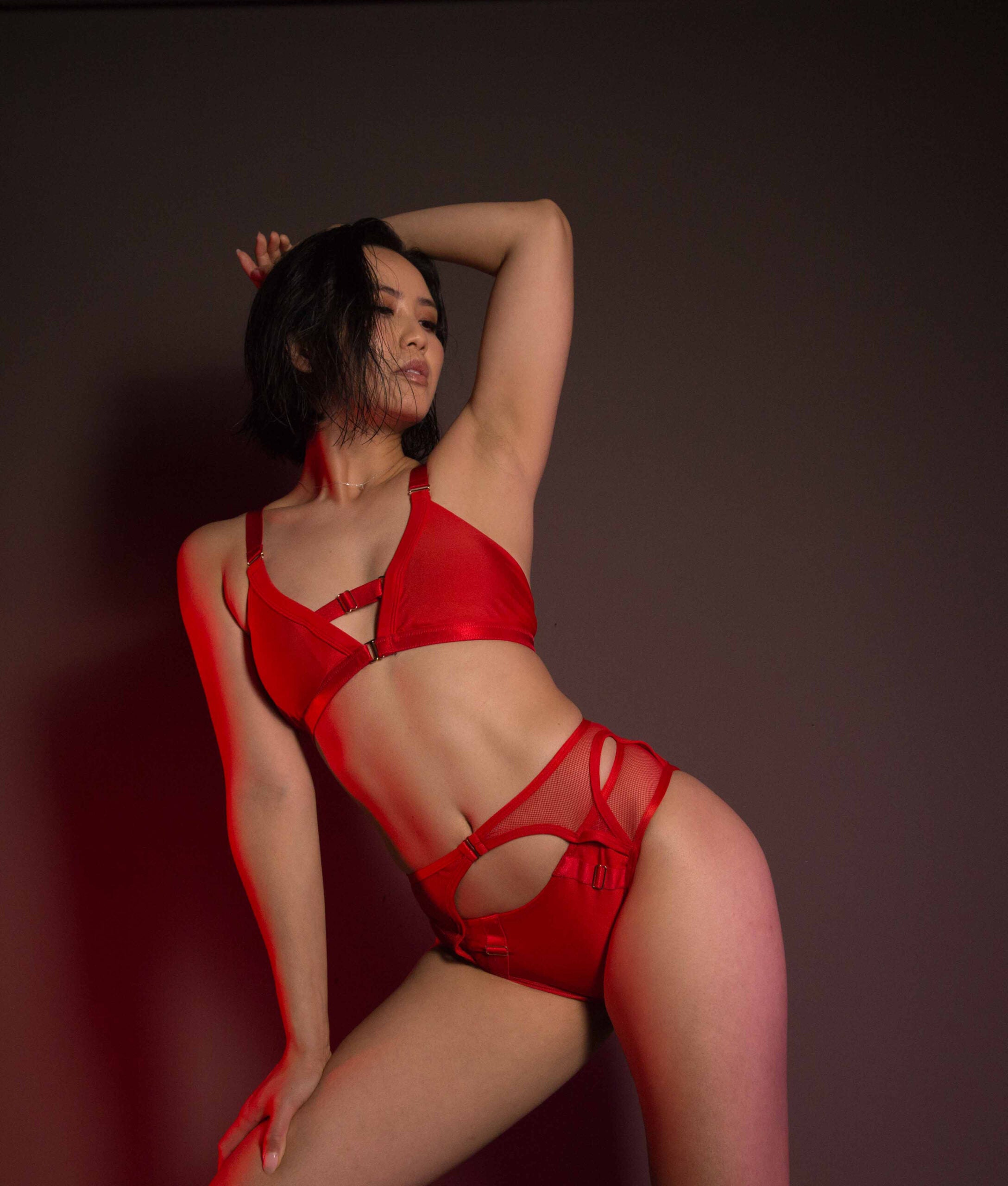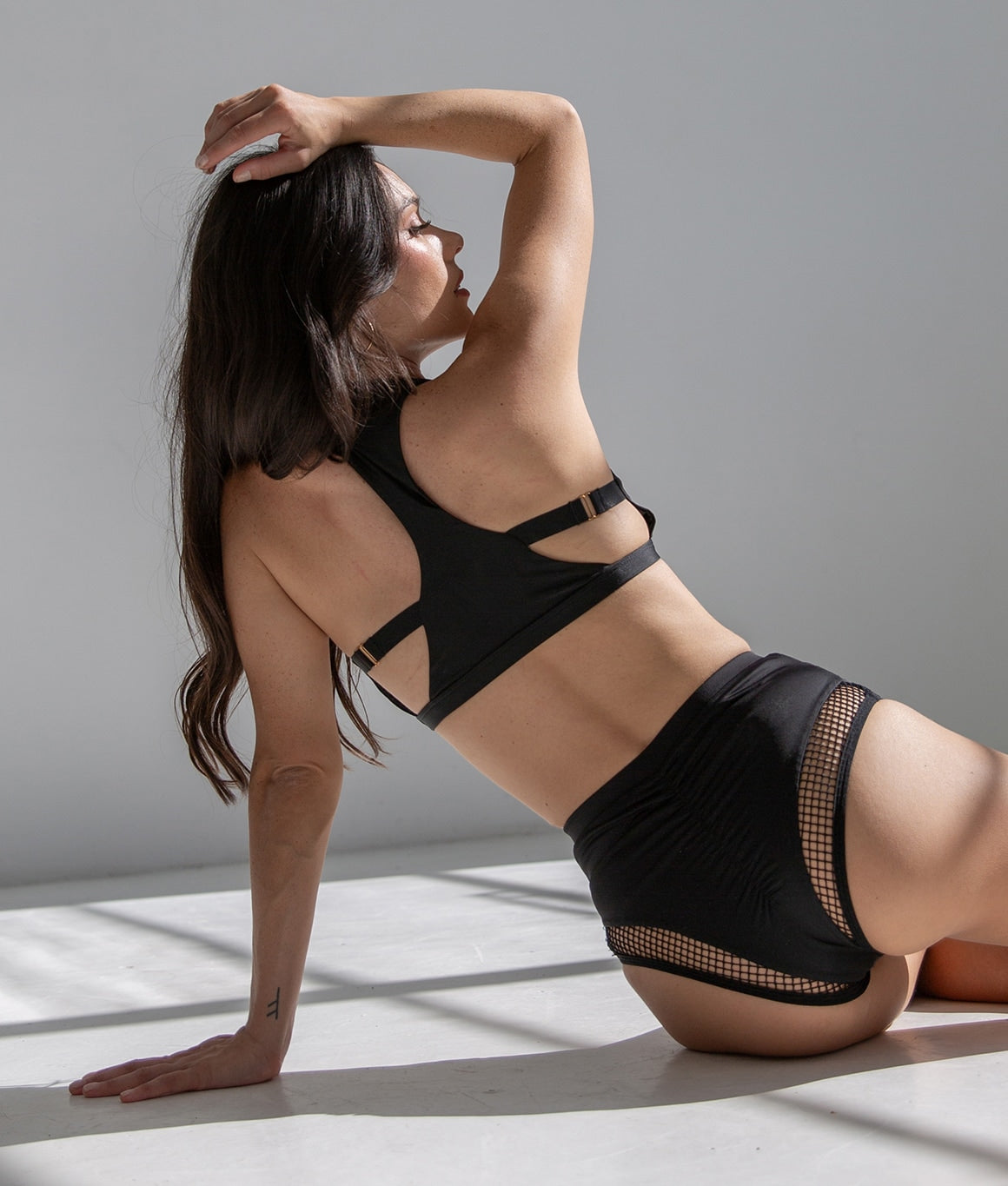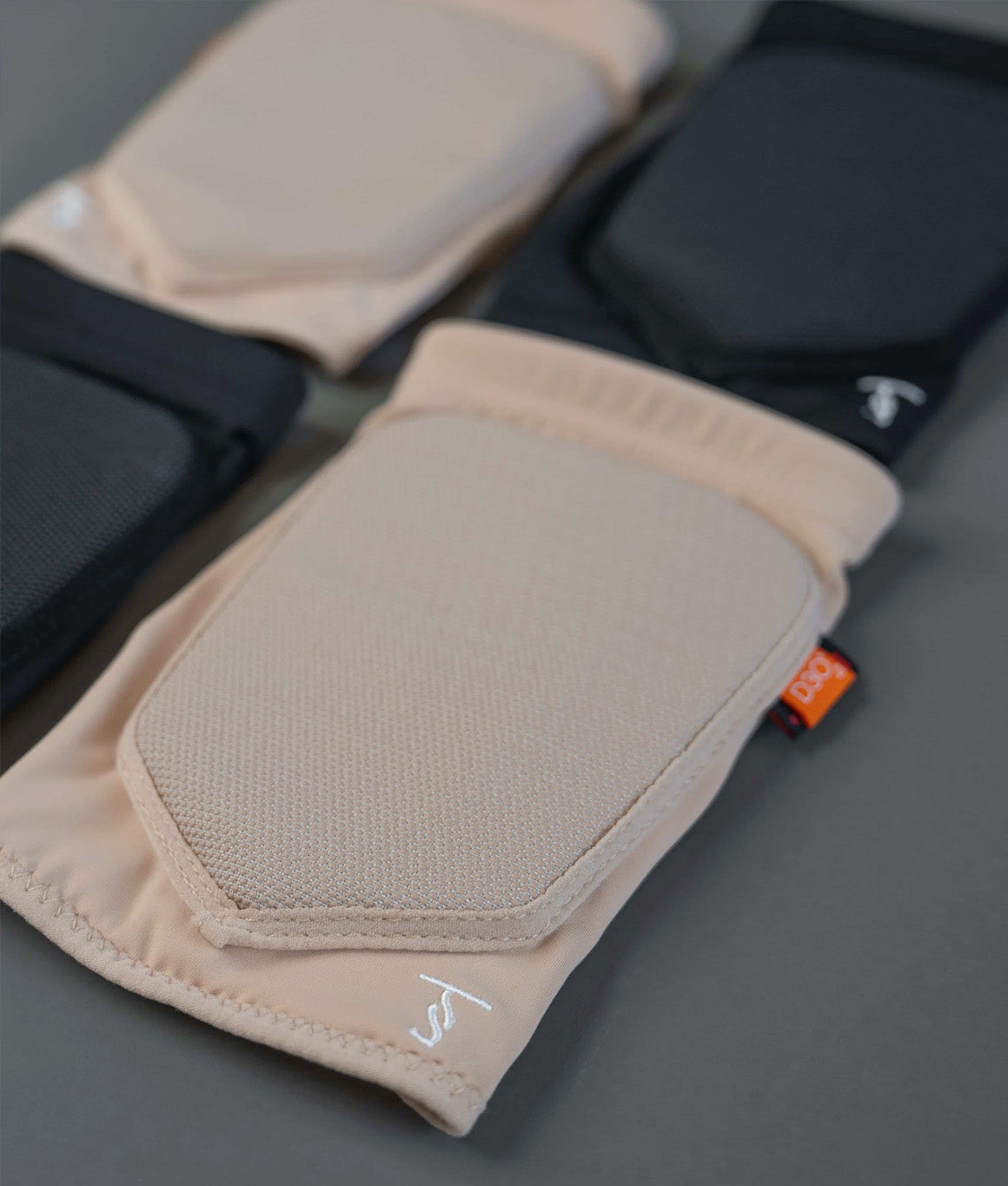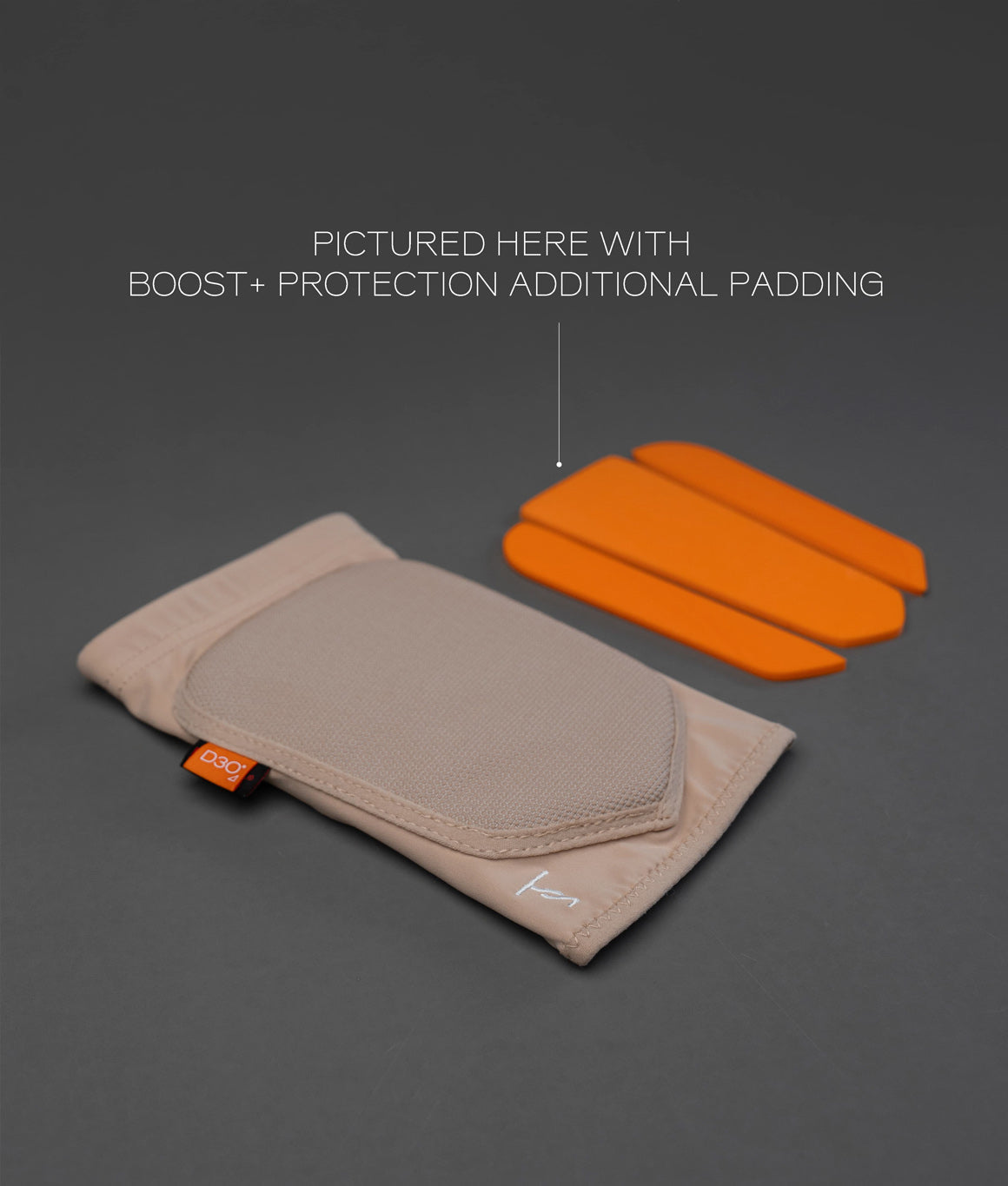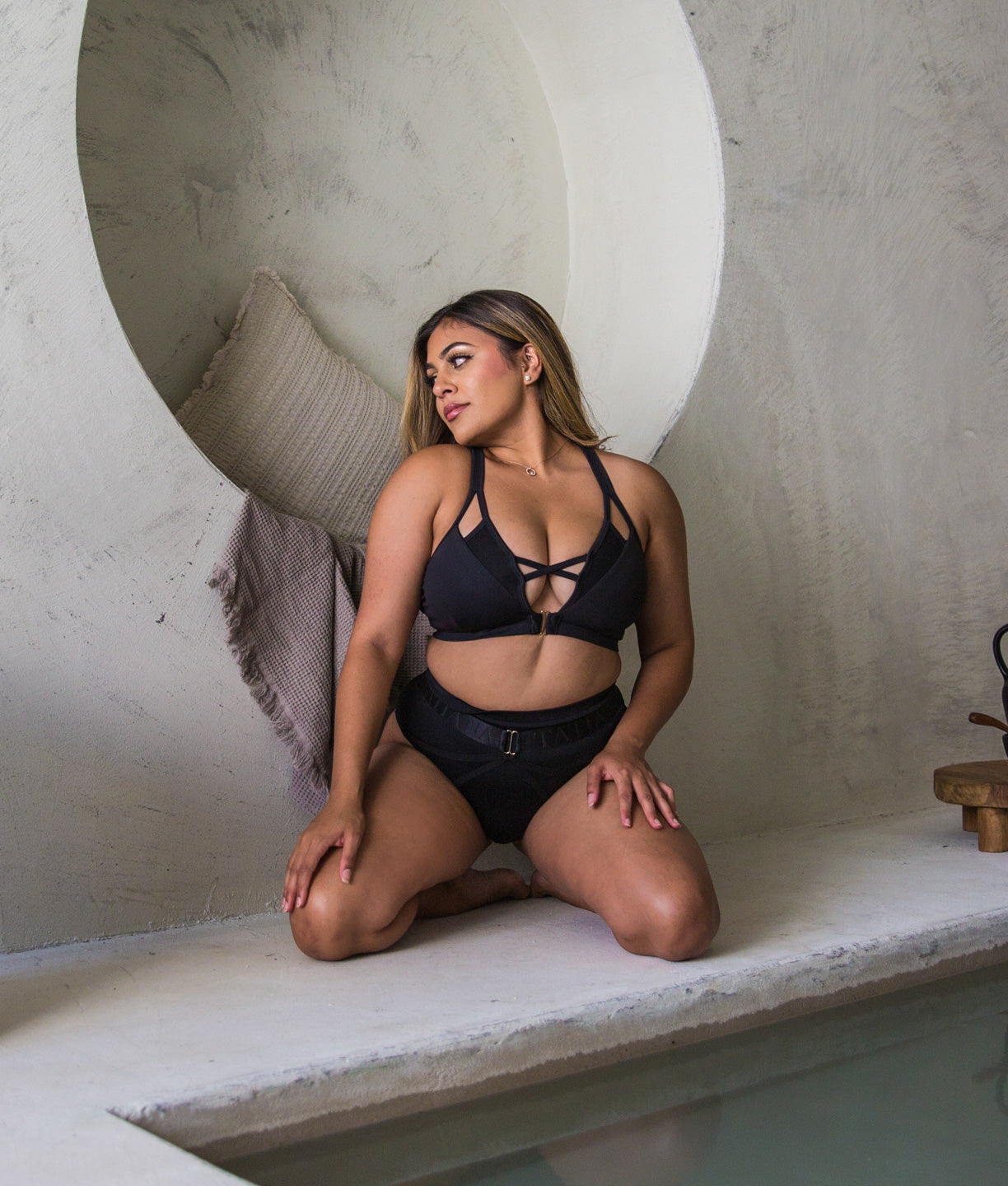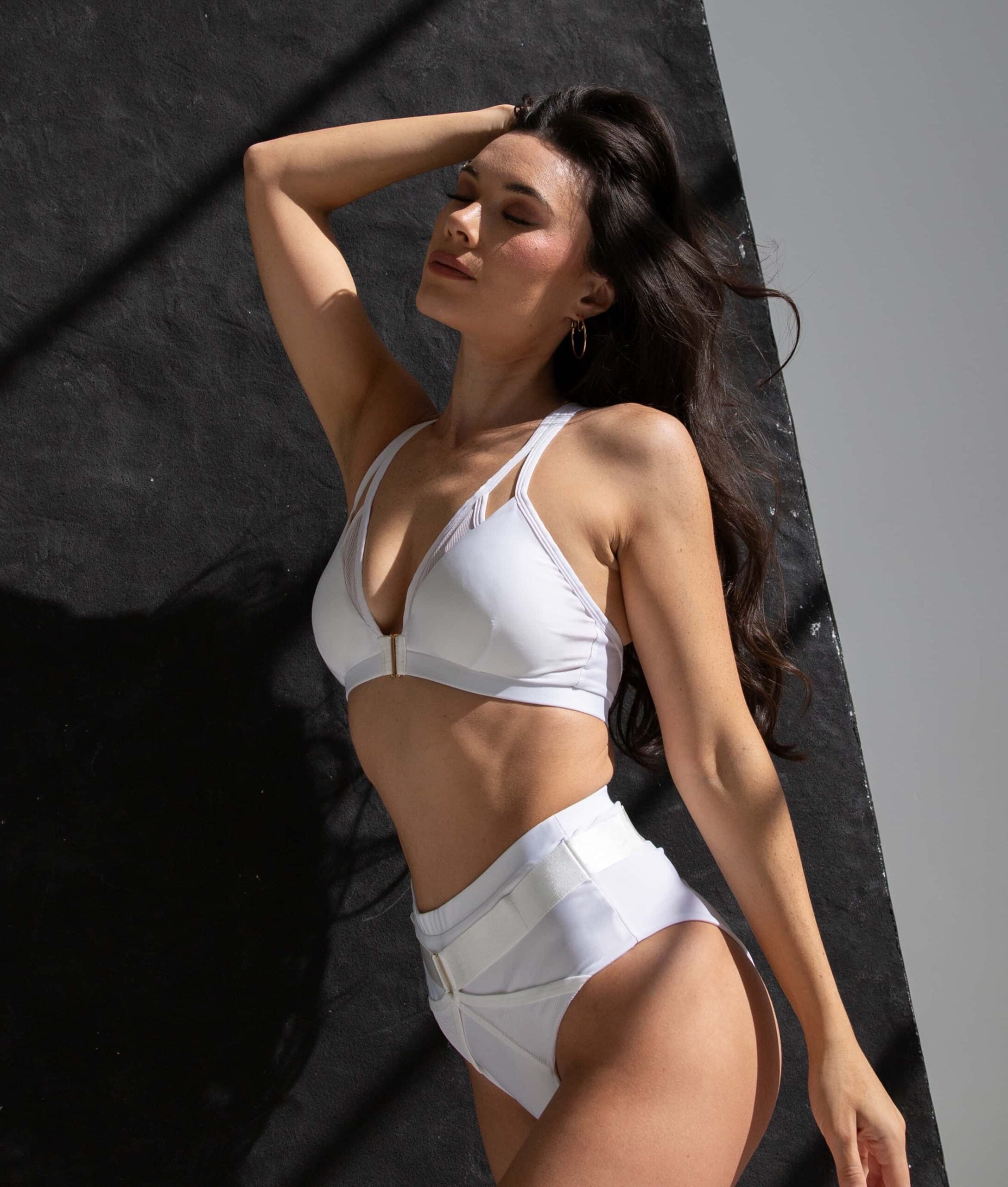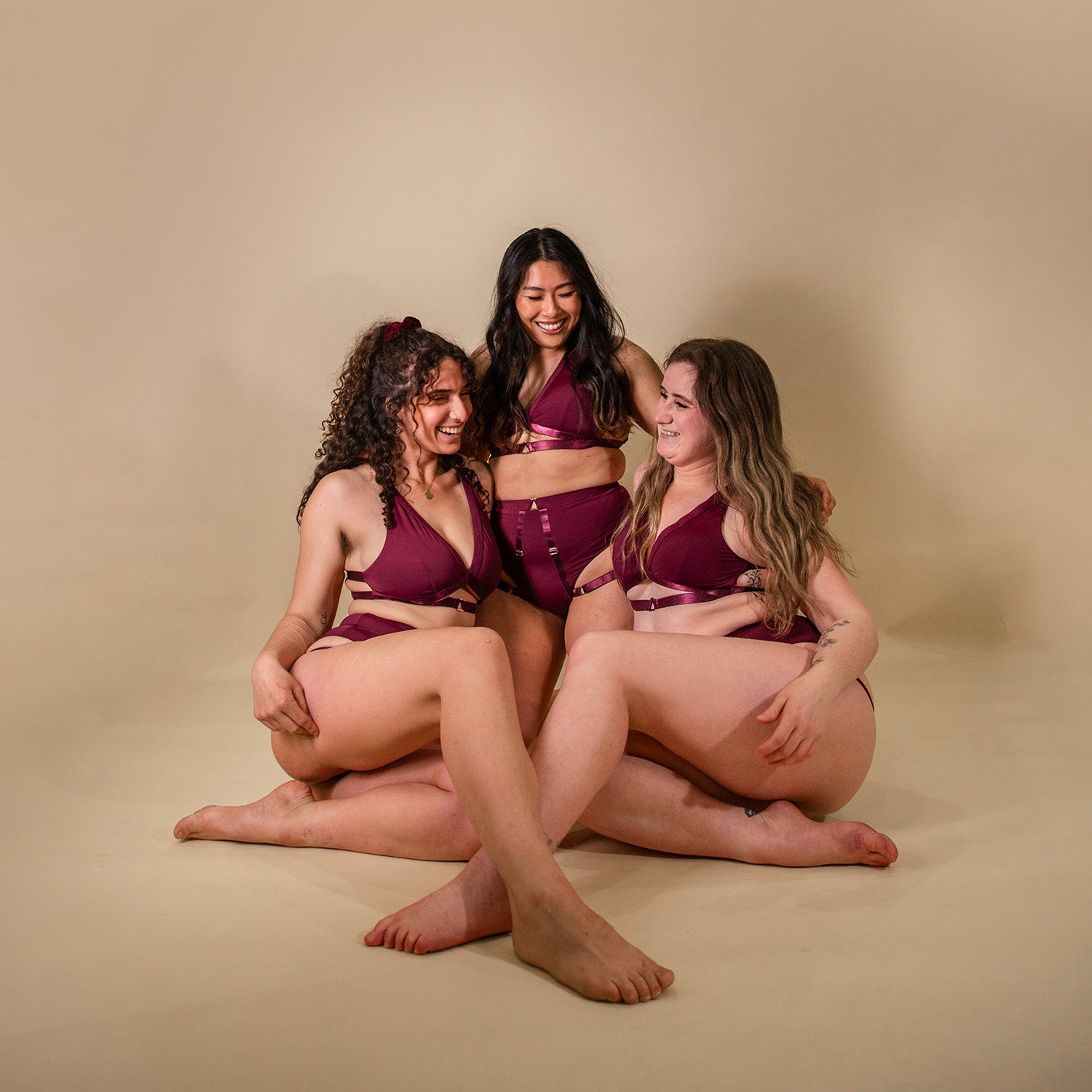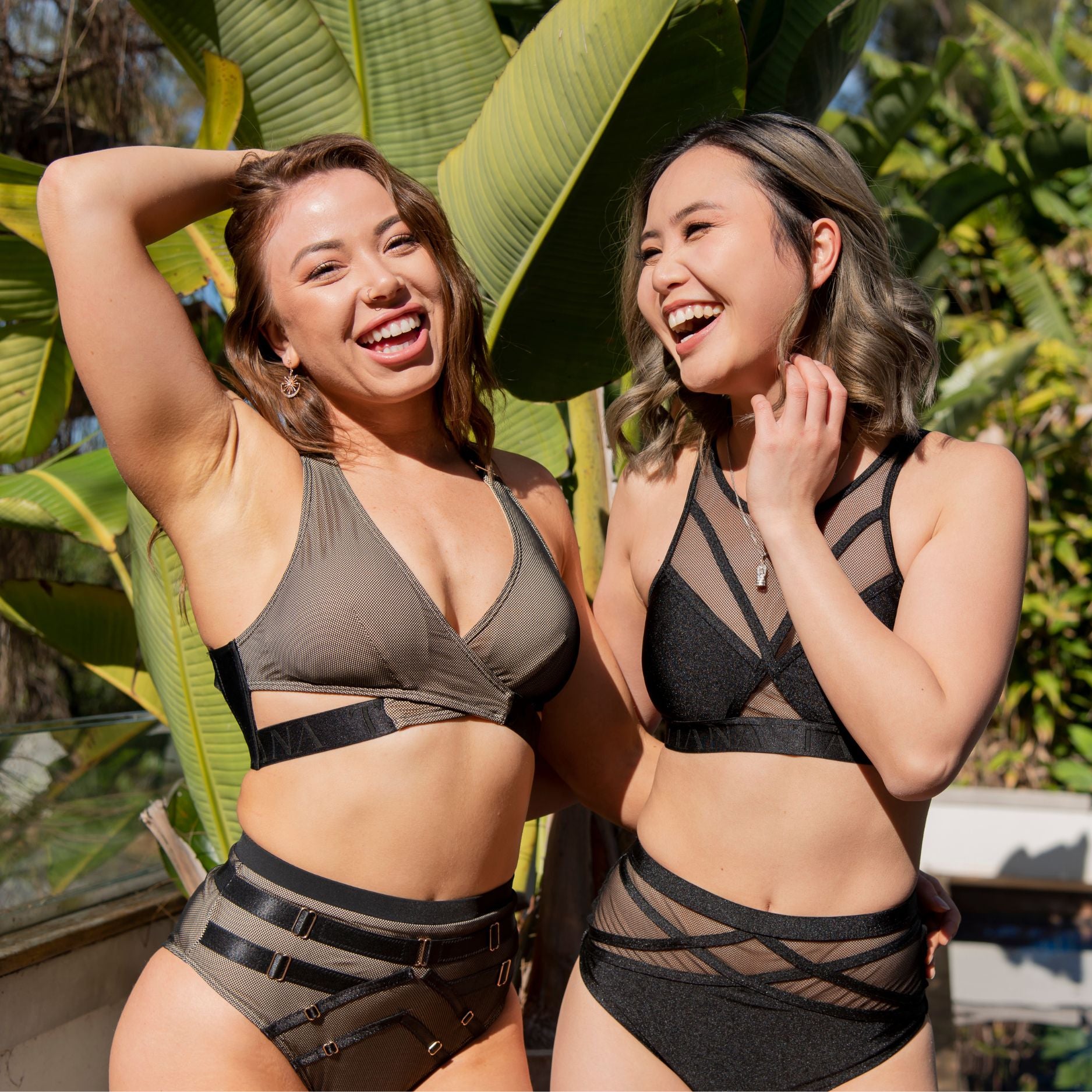
Why Every Pole Dancer Needs Protective Dance Knee Pads
When you start pole dancing (or any other kind of dancing e.g. contemporary dance, hip-hop, jazz etc), you may start to realise that there are certain moves that require your knees to come in contact with the floor. This becomes quite uncomfortable and even painful over time. And thus, this is why dance knee pads have been developed.

Whilst they may just look like a big old thing covering your boney knees, we’ll share what makes one knee pad different from another and how to choose a good knee pad.
Jump to:
- What are protective knee pads?
- How are dance knee pads different to other knee protectors?
- Why do you need knee pads for pole dancing?
- How should you choose dance knee pads?
What are protective knee pads?
As you slowly enter the world of pole dance choreography, you will find that about 60% of the moves require your knees to come into contact with the floor. The level of contact can be gentle or impactful. However, regardless as to whether it is gentle or impactful, it is uncomfortable for long periods of time.
To alleviate the discomfort, pole dancers generally resort to finding some kind of barrier or cushion to place in between their knees and the floor (studio floorboards, concrete floors, pole stages etc).
Your choice of a barrier or cushion generally comes in the form of a knee pad. Historically, the only knee pads available on the market were made with a cushion derived from EVA foam or gel. These provided a thicker barrier as opposed to just a fabric sleeve covering your knee.
EVA foam is made from ethylene-vinyl acetate (also used in skiing boots, running shoes etc) and when subject to regular pressure or impact overtime, it is unable to retain its cushy feel and ends up deflating (just like running shoes that need to be replaced every 500km or so). This means the barrier between your knees and the floor reduces overtime.
The same concept applies to gel padding however, gel padding feels ‘firmer’ against the knees (relative to EVA foam) and may have a lesser tendency to deflate overtime. Whilst it may have a lesser likelihood to deflate, it is subject to bursting.

Protecting your knees is incredibly crucial particularly when you begin training high impact tricks that require an abrupt and high pressure landing from kips, flips or drops. The repetitive impact or force from these movements overtime is definitely not a good thing for your knees. And so, when it comes to understanding the meaning of protecting your knees, the best kind of pole dancing knee pad is one that can absorb and then disperse the impact from all your kips, flips and drops.
How are dance knee pads different to other knee protectors?
If you were to search up the term ‘knee pads’ on google, you may find a variety of options available however, as pole dancers or dancers in general, we specifically require ‘dance knee pads’. Dance knee pads will generally have the following features:
- Slim silhouette shape to elongate a dancer’s lines
- Breathable fabric
- Soft padding that covers the knee cap/patella at the least

Here are main types of knee protectors that are generally available to purchase on the market:
Dance Knee Pads
These are especially made for dancers (contemporary dancers, ballet dancers, pole dancers etc) as they are generally made with fabrics that move and contour with your body. Outer materials are generally made of a soft fabric and the inner padding is not super heavy duty, bulky or dense in order to maintain the beautiful silhouette of a dancer’s legs.
Volleyball Knee Pads
Volley knee pads are generally made with a knitted fabric and EVA foam. The layer of EVA foam is generally quite thick to help absorb impact from dives etc. They are considered quite bulky to give volleyballers the most adequate protection properly however, the foam will generally deflate over time which will require replacing. The outer knitted fabric also has a tendency to tear over time (abrasion against floorboards during games and training) which again, will require replacing.
Industrial Knee Pads (used for construction, gardening etc):
These are constructed with a hard outer shell to withstand abrasion to hard surfaces outdoors such as concrete. It is designed for anyone that requires all day kneeling or kneeling for long durations. They are generally quite uncomfortable for dancers as the outer shell is rigid and dancers require mobility and flexibility with their knee pad.

Why do you need knee pads for pole dancing?
Your knee is a relatively boney part of your body and when subject to pressure or impact with the floor, it is downright uncomfortable. And so, having the right knee pad can alleviate both short and long-term pain.
As you progress through your pole journey and begin to explore the world of kips, flips and drops, the repetitive impact of learning these tricks can cause inflammation to your knee in the form of bursitis, etc. Further to this, floorwork is a large component of pole dancing (and contemporary, hip-hop or jazz!) which helps bring your choreography together and most of the time, sliding your bare knees on the floor will almost always guarantee friction burn.
As pole dancing is still considered a relatively new sport, the list of new problems and injuries are slowly beginning to emerge. Although some injuries may not be a direct result of pole dancing, it is more that pole dancing can aggravate pre-existing injuries stemming from other activities that caused the initial pain.
Some moves that 110% require knee pads due to the high impact include:
- Pole kips
- Pole flip
- Pole drops
And here are some floor work moves that cause extreme discomfort without knee pads due to the pressure or twisting of the knee skin on the floor:
- Russian kick up
- Knee spins
- Knee slides
Now, are you ready to read about the most exciting thing that has ever happened to knee pads in the pole and dance industry - pole dancing knee pads that actually protect your knees with science backed technology?!
How should you choose dance knee pads?
- Things to look out for when comparing knee pads: Padding, size, looks, grippiness, removable and replaceable padding, machine washability.
Padding
Choose a padding with science backed technology instead of something made with just EVA foam or gel. As mentioned previously, EVA foam will deflate overtime i.e. you will need to constantly replace your knee pad. Similarly with gel, whilst it may take a little bit longer to deflate or deform, there are no impact absorbing technology behind these two types of padding.
Consider a knee pad like the Tatiana Active Ultimate Knee Pad that uses D3O® technology for the padding. It feels like a foam but is much tougher and longer lasting. Upon impact, the foam hardens to protect you from the point of impact by distributing the force throughout the rest of the material and quickly softens up again. This is THE key difference between D3O® padding and EVA foam/gel.

Please note that whilst this padding contains impact protection properties, it is important that you read the care instructions to understand how to take care of your padding to ensure its technical properties are not compromised and it will ultimately last longer. This generally means avoiding moisture buildup overtime particularly after sweaty dance classes.
As with any other safety piece of equipment such as bike or ski helmets, it is subject to a finite amount of impact absorption. Please read the brand’s FAQ and product descriptions carefully to understand if and when you should replace your knee pads as the recommendations can differ from an instructor who trains 30 hours a week to a student who only takes two hours of classes a week.
Size & Stretch
When choosing a knee pad, it’s important to understand if the surface area of your knee will be covered. Anatomically speaking, knee sizes and shapes may vary across different people. Ensure that you find a knee pad brand that offers protection covering the top of the knee as well as the pointy shin bone as surprisingly, this is the point subject to the most impact for kips, flips and drops.
You’ll also need to ensure that you choose a size that is firm but not overly restricting. For example, if you choose a knee pad that is too big to begin with or has the tendency to stretch out (e.g. knitted fabrics) too much, the knee pad may shift at a crucial point in time e.g. when you are landing your kips, flips or drops which can expose your knee to a very painful high impact.
We also recommend reading the reviews about the knee pad that you are purchasing from and whether customers experience too much stretch over time i.e.the knee pad no longer fits or constantly shifts when wearing. This will give you a good indication as to whether you should size down or purchase a different brand that uses a fabric that is less likely to stretch out.
Shapes
Shapes do not differ too much across brands however, some:
- Have an opening at the back or grippy fabric which will allow you to perform certain tricks that require knee pit grip.
- Have extended shin bone coverage to help cover the pointy/protruding part of your shin that generally comes in contact with the floor first
- Are made with a longer sleeve which may give you a more slim silhouette but not necessarily provide more padding. Read the product description carefully to understand the padding size relative to the whole surface area of the sleeve
Consider your needs as well as the usage of the knee pad to purchase accordingly. E.g. If you are training high impact tricks, look for a knee pad that has padding that covers the shin bone to ensure you are fully protection i.e. avoid knee pads that are a circular shape only cover the knee cap.
If you are looking for a floorwork style knee pad (that only has knee cap protection as shown below on the right) and only require minimal protection, you can opt for more minimal knee pads. Note that these minimal knee pads will generally not have adequate side coverage for moves like floor twerking.

A few extra points worth mentioning:
- Advanced pole dancers have built body awareness and strength over time which allow them to not rely on a knee opening or sticky grip at the back for certain tricks whereas;
- A beginner pole dancer who is just beginning to understand the strength required for certain knee grips will rely more on the opening at the back or the sticky grip for certain tricks
Removable and Replaceable Padding
Depending on what knee pad you choose to go with, it’s important to purchase a knee pad that is machine washable. After multiple sweaty classes, it would be slightly unhygienic (and smelly!) for you to not be able to wash it. Thankfully, most knee pads on the market are machine washable!
Ideally, we recommend purchasing knee pads that have removable padding or padding that can be washed without affecting its technical properties. (EVA foam and gel can generally be washed as they do not have any technical properties that can be damaged by washing detergent or water temperatures whereas, D3O® padding cannot be subject to water, detergent or high water temperatures as it can alter the technical impact protection properties.)

Replaceable and removable padding will also allow you to save a little bit of money as opposed to buying a brand new knee pad. Padding may need to replaced for various reasons:
- It has become way too smelly
- The padding has deflated/deformed
- Impact protection properties have diminished
Outer Material
Current knee pads on the market are generally made with either: polyester elastane, nylon elastane or knitted fabrics.
- Polyester generally is quite durable however is not considered a very breathable fabric and so, the knee pad can feel quite sweaty very quickly and not dry so easily
- Nylon has more breathable properties than polyester. It’s great and washable, breathable, and quick drying.
- Knitted fabrics may feel quite comfortable against the skin however, when subject to heavy amounts of floor work overtime, the woven fabric will generally get caught on floorboards and then tear over time. Knitted fabrics also have a tendency to stretch out a little too much over time causing the knee pad to constantly shift. This may then require you to replace the whole knee pad on a regular basis.

Here at Tatiana Active, we offer something truly innovative that includes an outer material that is neither of the above mentioned - SuperFabric®. SuperFabric® is a cut and abrasion resistant fabric which ultimately allows your knee pads to last up to 10 times longer (if not more) than regular knee pads on the market which use polyester, nylon or knitted fabrics.
Designed by a pole dancer herself, Tatiana understood what pole dancers needed:
- Something that can withstand our high impact tricks
- Something that can withstand all our floorwork (floorwork is highly abrasive and is generally the main cause of knee pads tearing)

SuperFabric® combined with a silky smooth and breathable nylon elastane yields the ultimate marriage of comfort and durability. Learn more about the Tatiana Active Ultimate Knee Pads here.
Velcro or no Velcro:
Generally speaking, the lifespan of velcro is limited and over time, the stickiness of the velcro will diminish. However, the great upside to velcro is accessibility - it’s easy to put on and take off (especially if you have accidentally popped your heels on already!).
Consider this when you purchase knee pads as you may need to replace the velcro section when it does wear out.
Price & Future Replacement Costs
Last of all, price. If you decide to purchase a knee pad at a lower price point that is made from EVA foam or gel, please consider the amount of money you will be needing to spend for replacements.
We recommend doing your research and weighing up the costs of a more technical dance knee pad against the amount of times you may need to replace or repair a standard knee pad with no technical properties or materials.
We hope you have enjoyed a thorough deep dive into the world of knee pads and will be able to make an informed decision when purchasing your next knee pad. Just remember that you only have one set of knees so do everything you can to keep them happy and healthy (surgeries and rehab are no fun)!
Want to learn more about how to care for your knees as a pole dancer? Check out our in-depth blog, Deep Dive - Pole and Knee Health (What The Professionals Have To Say), where physiotherapists and pole experts weigh in on injury prevention and long-term knee health in pole dancing.

